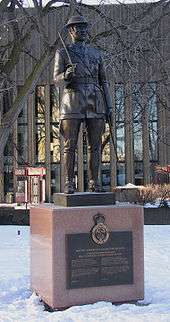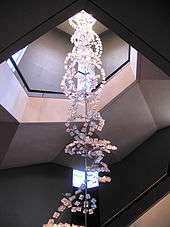National Arts Centre
| National Arts Centre Centre national des Arts (French) | |
|---|---|
|
| |
| Location | Ottawa, Ontario, Canada |
| Coordinates | 45°25′23″N 075°41′38″W / 45.42306°N 75.69389°WCoordinates: 45°25′23″N 075°41′38″W / 45.42306°N 75.69389°W |
| Built | 1969 |
| Current use | Arts centre |
| Architect | Fred Lebensold |
| Website |
www |
| Designated | 2006 |
The National Arts Centre (NAC) (French: Centre national des Arts) is a centre for the performing arts located in Ottawa, Ontario, between Elgin Street and the Rideau Canal. The National Arts Centre was designated a National Historic Site of Canada in 2006.[1][2]
History
Ottawa did not have a major performing arts venue after 1928 when the Russell Theatre was expropriated and demolished to make way for Confederation Square. Performers and orchestras visiting the capital were required to use the stage of the Capitol Cinema, which had been designed for vaudeville and films. In 1963, an organization named the National Capital Arts Alliance was founded by G. Hamilton Southam and Levi Pettler. They successfully convinced the city and government to build the new centre.
The NAC was one of a number of projects launched by the government of Lester B. Pearson to commemorate Canada's 1967 centenary. It opened its doors to the public for the first time on 31 May 1969[3] having cost C$46 million to build. The site at one time was home to Ottawa City Hall, and the city donated the land to the federal government. Conductor Jean-Marie Beaudet served as the NAC's first music director (1969-1971). In June 2010 a life size bronze statue of the Canadian jazz pianist Oscar Peterson was unveiled outside the NAC by Queen Elizabeth II during her royal tour of Canada.[4]
In February 2014, the centre unveiled a new logo and slogan, Canada is our stage, in preparation for its fiftieth anniversary in 2019. The former logo had been designed by Ernst Roch and was in use since the centre's opening.[5]
Architecture


The building, designed by Fred Lebensold, is in the Brutalist style and based on the shape of a triangle and hexagon. The building is constructed of reinforced concrete. The exterior and many interior walls are faced with precast concrete panels containing exposed aggregate of crushed brown Laurentian granite.[2] The center rises from a base that sits on a 950-space underground parking garage. The base houses offices, lobbies, dressing rooms, workshops and a restaurant. The site slopes from Elgin Street to the Rideau Canal allowing for a second underground level overlooking the canal. The roof of the base forms a multi-level terrace containing gardens that are open to the public and connects to the Mackenzie King Bridge. The three main performance spaces rise from the base as a series of hexagonal structures also faced with brown precast panels in a variety of textures. Windows are tall, narrow slits framed by vertical ribs. The hexagonal theme flows through the interior and appears in ceilings, light fixtures and flooring. Lobbies and stairwells house several major pieces of visual art.
Plans for the centre included an organ in Southam Hall, however funding did not permit this. On 17 March 1970, the 25th anniversary of the liberation of the Netherlands, a Dutch-Canadian Committee presented two organs purchased as the result of its Operation Thankyou Canada. The 21-stop concert organ and positiv organ were both constructed by the Flentrop Orgelbouw of Zaandam and given in gratitude for the role played by Canadian troops in the liberation of the Netherlands. The concert organ premiered in a recital 7 October 1973 by Albert de Klerk.[6]
In 2000, the NAC was named by the Royal Architectural Institute of Canada as one of the top 500 buildings produced in Canada during the last millennium.[7]
Artistic aims and performances presented
One of the largest performing arts facilities in Canada, at 1,158,000 sq ft (107,600 m2), the NAC works with thousands of artists, both emerging and established, from across Canada and around the world, and collaborates with dozens of other arts organizations across the country. The NAC operates in the performing arts fields of classical music, English theatre, French theatre, dance, variety, and community programming. The NAC supports programs for young and emerging artists and programs for young audiences, and producing resources and study materials for teachers. The NAC is the only multidisciplinary, bilingual, performing arts centre in North America, and one of the largest in the world.
The National Arts Centre is home to the National Arts Centre Orchestra, considered one of the world's leading classical-size orchestras. Alexander Shelley, a conductor, pianist, cellist and teacher, has been the orchestra's music director since 2015. The artistic director of English Theatre is Jillian Keiley; the artistic director of French Theatre is Brigitte Haentjens; Cathy Levy is the executive producer of dance; Heather Moore is producer and executive director of the Scene Festivals; Heather Gibson is producer of NAC Presents. The National Arts Centre produces a French language podcast presented by Cathy Levy which interviews dancers and people involved in dance performances at the venue.[8]
Kurt Waldele was executive chef for two decades, up to his death in 2009. His successor Michael Blackie, was responsible for creating "Celebrity Chefs of Canada" which ran for the both 2011 and 2012. In late 2012 Michael left the NAC to develop his own business in Ottawa located in the west end called NeXT. In 2013 John Morris was promoted to the position executive chef. John Morris worked under chefs David Garcelon, Michael Blackie and Steven Gugelmeier
The National Arts Centre is co-producer of the Canada Dance Festival and co-founder of the Magnetic North Theatre Festival, which it operates in partnership with the Canadian Theatre Festival Society.[9][10] The Magnetic North Theatre Festival is an annual event first held in Ottawa in 2003, where it is held every second year, being held in other Canadian cities in the alternating years.[11][12] The festival offers not only productions and performances for the theatre-going public, but offers workshops and seminars aimed at theatre students and professionals.[11]
Performance facilities
The NAC has four stages:
- Southam Hall, with 2,323 seats, is the largest stage and is home to the National Arts Centre Orchestra and the Ottawa Symphony Orchestra, Opera Lyra Ottawa, as well as ballet and other major visiting shows and productions.
- The Theatre, with 897 seats, is mostly used for theatre and dance events. It has been home to the English-language and French-language theatre companies.
- Studio, with 300 seats, is a theatre venue suited for performances requiring a more intimate space.
- The Fourth Stage, with 150 seats, opened in 2001 and is home to a wide variety of community programming.
See also
References
- ↑ National Arts Centre, Directory of Designations of National Historic Significance of Canada
- 1 2 "National Arts Centre National Historic Site of Canada". Canada's Historic Places. 27 November 2006. Retrieved 2012-01-03.
- ↑ Barrie, Judy (June 2, 1969), "40,000 agog but centre's debut shaky", The Ottawa Citizen, p. 13
- ↑ Martin Knelman (29 June 2010). "Knelman: Oscar Peterson's piano lives on in Ottawa". Toronto Star. Retrieved 15 August 2015.
- ↑ Adams, Jane (February 26, 2014). "National Arts Centre unveils first new logo in 45 years". The Globe and Mail. Retrieved 2015-06-23.
- ↑ "Two Flentrop Organs are gifts of the Dutch-Canadian Community to Canada". NAC. Retrieved 2012-01-03.
- ↑ Cook, Marcia (11 May 2000). "Cultural consequence". Ottawa Citizen. Canwest. Retrieved 2009-10-11.
- ↑ "Danse CNA Podcast". French Podcasts. Retrieved 2014-12-15.
- ↑ "Magnetic North Theatre Festival". Canadian Theatre Encyclopedia. Retrieved 2011-06-29.
- ↑ Jennings, Sarah (2009). Art and Politics: The History of the National Arts Centre. Toronto: Dundurn Press. pp. 327–330. ISBN 978-1-55002-886-7.
- 1 2 Andrew Snowdon (9 May 2011). "Magnetic North Returns to Ottawa for 2011". Canada Arts Connect Magazine. Retrieved 2012-01-03.
- ↑ Jessica Werb (27 March 2008). "Magnetic North Theatre Festival lineup revealed". The Georgia Straight. Retrieved 2008-08-17.
Further reading
- Jennings, Sarah (2009), Art and politics: the history of the National Arts Centre, Dundurn, ISBN 978-1-55002-886-7
External links
| Wikimedia Commons has media related to National Arts Centre. |